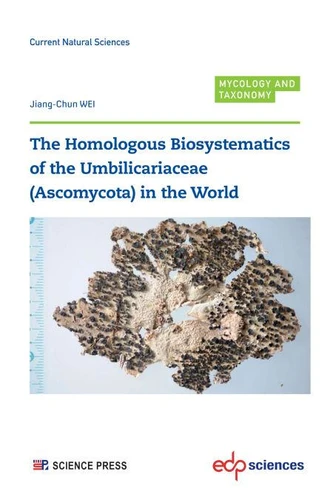The Homologous Biosystematics of the Umbilicariaceae (Ascomycota) in the World
Par :Formats :
Disponible dans votre compte client Decitre ou Furet du Nord dès validation de votre commande. Le format PDF est :
- Compatible avec une lecture sur My Vivlio (smartphone, tablette, ordinateur)
- Compatible avec une lecture sur liseuses Vivlio
- Pour les liseuses autres que Vivlio, vous devez utiliser le logiciel Adobe Digital Edition. Non compatible avec la lecture sur les liseuses Kindle, Remarkable et Sony
 , qui est-ce ?
, qui est-ce ?Notre partenaire de plateforme de lecture numérique où vous retrouverez l'ensemble de vos ebooks gratuitement
Pour en savoir plus sur nos ebooks, consultez notre aide en ligne ici
- Nombre de pages282
- FormatPDF
- ISBN978-2-7598-3443-3
- EAN9782759834433
- Date de parution29/08/2024
- Protection num.Digital Watermarking
- Taille69 Mo
- Infos supplémentairespdf
- ÉditeurEDP Sciences
Résumé
Biosystematics is the science of studying biodiversity and its relationships in nature. It aims to divide the biodiversity into monophyletic taxa of different grades based on their relationships, such as species, genera, families, orders, classes, phyla, and kingdoms.
Homologous biosystematics is to comb diverse organisms in nature into different classes of monophyletic taxa according to their homologous characteristics.
The homologous characteristics are inherited from both the genotype and phenotype of the same ancestor, and they have been associated with divergent evolution. In this book, the author presents the result of a homology analysis of homologous characteristics in the specimens of the Umbilicariaceae from the world. It contains an introduction, biosystematics, and taxonomy, which contains 125 species respectively belonging to the genera Lasallia and Umbilicaria including 34 new species with one new form and one new name.
Each species has one or more color photographs attached. The references cited and index of scientific names for taxa are also attached.
The homologous characteristics are inherited from both the genotype and phenotype of the same ancestor, and they have been associated with divergent evolution. In this book, the author presents the result of a homology analysis of homologous characteristics in the specimens of the Umbilicariaceae from the world. It contains an introduction, biosystematics, and taxonomy, which contains 125 species respectively belonging to the genera Lasallia and Umbilicaria including 34 new species with one new form and one new name.
Each species has one or more color photographs attached. The references cited and index of scientific names for taxa are also attached.
Biosystematics is the science of studying biodiversity and its relationships in nature. It aims to divide the biodiversity into monophyletic taxa of different grades based on their relationships, such as species, genera, families, orders, classes, phyla, and kingdoms.
Homologous biosystematics is to comb diverse organisms in nature into different classes of monophyletic taxa according to their homologous characteristics.
The homologous characteristics are inherited from both the genotype and phenotype of the same ancestor, and they have been associated with divergent evolution. In this book, the author presents the result of a homology analysis of homologous characteristics in the specimens of the Umbilicariaceae from the world. It contains an introduction, biosystematics, and taxonomy, which contains 125 species respectively belonging to the genera Lasallia and Umbilicaria including 34 new species with one new form and one new name.
Each species has one or more color photographs attached. The references cited and index of scientific names for taxa are also attached.
The homologous characteristics are inherited from both the genotype and phenotype of the same ancestor, and they have been associated with divergent evolution. In this book, the author presents the result of a homology analysis of homologous characteristics in the specimens of the Umbilicariaceae from the world. It contains an introduction, biosystematics, and taxonomy, which contains 125 species respectively belonging to the genera Lasallia and Umbilicaria including 34 new species with one new form and one new name.
Each species has one or more color photographs attached. The references cited and index of scientific names for taxa are also attached.



